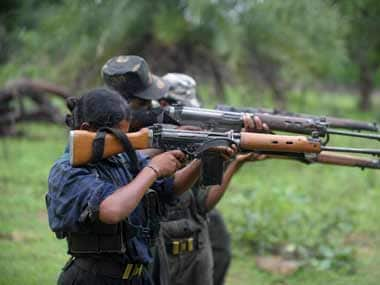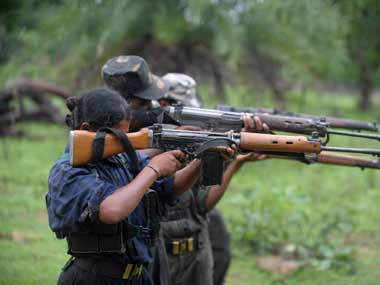Salwa Judum is dead. Long live Bastar Sangharsh Samiti. Bastar Sangharsh Samiti is dead. Long live Samajik Ekta Manch. Samajik Ekta Manch is dead. Long Live Agni (Action Group for National Integrity). In a Chhattisgarhi version of William Shakespeare, an anti-Maoist group by any other name would still be an anti-Maoist group. All the four groups mentioned above are men without uniform backed by men in uniform. A mask to show that civil society wants a Maoist-free Bastar. Nothing wrong with it but for the strong-arm tactics reportedly practiced by using civilians as shields. [caption id=“attachment_2949670” align=“alignleft” width=“380”]  Representational image. AFP[/caption] In official parlance, this is referred to as ‘Mission 2016’. Which means to get Bastar in South Chhattisgarh rid of Maoists by December this year. With time running out, on the ground, it means to nudge the tribals to push the Naxals out of the villages of Bastar and target all those journalists, lawyers and activists who stand up to the extra-constitutional methods adopted by the security forces in the war against Naxalism. In the last few days, three different developments have taken place in south Chhattisgarh. This is that part of India in whose goings-on the rest of India remains largely disinterested unless there is statistical pornography on display, which means when the security forces or the Maoists kill each other in large numbers. On Saturday, the newly formed group Agni organised a rally titled ‘Lalkar’, a bid to raise the decibel levels against Maoist violence and their supporters. But the organisers were unable to hide the fact that Agni was merely Samajik Ekta Manch, reborn in a new avatar. Old anti-Maoism in a new bottle. The mai-baap remained the same men in CRPF and police uniform, firmly holding the remote control in their hand, with this vigilante group tasked to play its part in the narrative. The other development involves Manish Kunjam, a CPI leader who was part of the team of mediators to negotiate with the Maoists when Sukma district collector Alex Paul Memon was abducted by Naxals in 2012. There has been a public outrage to one of his Facebook posts in which he wrote objectionable matter about a Hindu Goddess. Given that Kunjam is seen as a pro-Maoist ideologue, the angst against him is being milked by his detractors as well. And finally, Prabhat Singh, a Dantewada-based journalist who went missing for two days after Saturday. His family was in panic, fearing he had been picked up by the Bastar police. Prabhat has managed to get out of Dantewada now, but according to his friends, he fears arrest and is seeking legal advice on how to stay safe. Prabhat knows he is a marked man, as earlier this year, he was arrested for using a slang term against a senior security officer on a Whatsapp group. He has been out on bail. In the theatre of terror in Chhattisgarh, the eyeball to eyeball confrontation between the state and the Maoists is only making many go blind with hatred. Ever since united Andhra Pradesh with a sustained police offensive in 2005-06 pushed the Maoists out of its territory, they have made the other side of the Godavari river their safe haven. Over the last decade, Maoist sympathisers have claimed that 70 percent of south Chhattisgarh is under the control of the heavily armed outlaws. In fact, the National Highway 30 that starts from Konta, just when you get into Chhattisgarh from Andhra Pradesh, exists only in name. It is a highway of dust, extreme poverty and governmental neglect where you will find the Maoist sarkaar taking charge if you move 5 km inside on either side of NH 30. The Chhattisgarh government admits this as well on record, saying at least 15 gram panchayats in Konta are absolutely no-go areas. Many other villages are approachable only after a thorough security check. The Maoist regime, by the police’s own admission, has at least 5000 armed cadres in the seven districts of south Chhattisgarh, with over 20000 sympathisers, acting as their eyes and ears. The Naxals have formed Regional Political Councils for every cluster of ten villages whose representatives — up to 14 in each village — are armed with countrymade weapons. Warzone Bastar has been, for all practical purposes, outsourced to the CRPF, whose heavily fortified camps one can find every 5 km. It has been a long-drawn war against India’s greatest internal security threat. And with no signs of any end soon, the forces are getting weary and want to fight to the finish. Which is why the focus all through 2016 has been to cut off their (what the police calls) ‘propaganda’ funnels overground. Earlier this year, two lawyers, Shalini Gera and Isha Khandelwal of the Jagdalpur Legal Aid Group were forced to leave Jagdalpur for providing free legal assistance to tribals since 2013. But like with all such actions, the police was nowhere on the scene. It was the landlord who served them the eviction notice. The plan seems to be to cut the lines of communication to wage a war without witnesses. Keep the outsiders out, while forcing the locals to fall in line. Journalist Malini Subramaniam’s articles made the establishment see red. Especially when she chronicled alleged human rights violations by the forces. Just like Isha and Shalini, the landlord was forced to make her vacate her house in Jagdalpur this February, forcing her to flee to Hyderabad. The journalistic space has indeed shrunk in south Chhattisgarh over the years. Most scribes know the price they will have to pay if they write against the government or against the Maoist. Boundaries are defined. In the past, Naxals have killed while the police have arrested journalists. The pen or the camera is no match for the gun. News organisations based in Chhattisgarh also do not encourage criticism of the system. Vijay, a member of the Samajik Ekta Manch who I met in March talked about how the outsiders do not know about the ethos and the ecosystem of Chhattisgarh and are backing the wrong guys. The Chhattisgarh template of the national vs anti-national debate paused when the Samajik Ekta Manch was wound up after criticism of its strong arm tactics. Now having taken birth in a new form with Agni, it is expected to ignite a fresh fire in the anti-Maoist movement in Chhattisgarh. The labeling, most expect,will begin all over again. And Bastar will remain a land at war with itself.
In the theatre of terror in Chhattisgarh, the eyeball to eyeball confrontation between the state and the Maoists is only making many go blind with hatred.
Advertisement
End of Article


)
)
)
)
)
)
)
)
)



